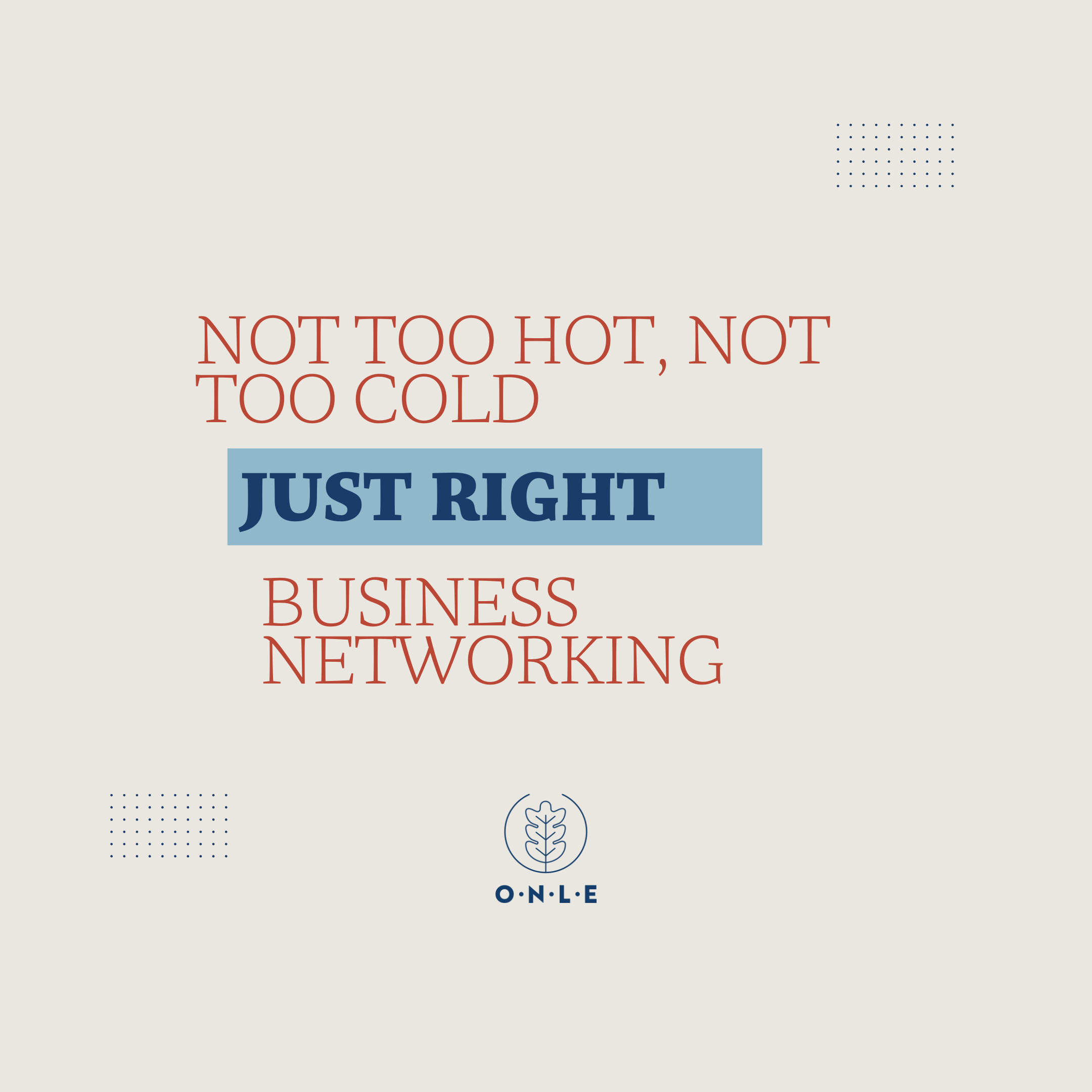Goldilocks business networking: finding the “just right” approach
There are broadly three ways to approach business networking. Only one yields constant, long-term results. James West, co-founder of ONLE, explains how to find your perfect business networking recipe.
One of the challenges with getting results at business networking is that no absolute model or rule book that leads you to results. This means most people build a piecemeal strategy based on observing others, applying logic and good old-fashioned trial and error.
This can lead to many weird and wonderful variations of networking. And in my experience, it leads most people to one of two extremes: the ‘too hot’ and ‘too cold’ business networking approaches. Before I can explain the ‘just right’ sweet spot you’re looking for, here’s what I mean by the two extremes:
Too hot: The pushy prospector
These networkers flit from event to event, armed with a pitch and a sales agenda. They contribute little, but expect to get sales from every room they walk into.
Sometimes they get work—usually by luck, or because their offer happens to align with someone’s need. But they rarely build lasting connections. And over time, people begin to notice their pattern and disengage. In short: the prospector can get short-term results at networking, but it’s inefficient and unsustainable because they burn bridges and exhaust their networking opportunities. Plus, it’s EXHAUSTING and demoralising.
If you want to try this approach, I suggest cold-calling via the phone or on Linkedin. You’ll likely get a similarly low yield, but it’s less time-consuming and more honest!
James West, ONLE Networking
“It’s the nice-person networkers who often get stuck. They’re doing the right things - but without a clear strategy, they’re not getting results.”
Too cold: The unassertive ‘nice person’
We all want to be accepted and known for being a nice person. And we certainly don’t want to be one of those pushy salespeople who backs you into a corner at networking and make you feel uncomfortable. So we go the other way - avoid sales and instead focusing on being a nice person.
These are the givers. The people-pleasers. They avoid pitching, try their best to support others, and are a delight to be around. But in their haste to avoid being aggressive, they avoid asking for ANYTHING. Their offer may be vague (“If you know anyone who needs me…”) and their product ladder is unclear.
These people often feel frustrated. It’s understandable - they’re doing what seems right—but the referrals and sales don’t come. Why? Because they’re hard to help.
If you’re not specific, strategic and easy to refer, your network can’t connect the dots for you.
We’ve noticed a pattern: it’s the nice-person networkers who often get stuck. They’re doing the right things—helping others, turning up regularly, avoiding sleazy tactics—but without a clear strategy, they’re not getting results.
Just right: The at-ease, strategic networker
The just-right networker builds goodwill through generosity and being relatable. They lead with helping others. They listen. They build relationships and a reputation for being reliable and enjoyable to talk to. But they also communicate clearly:
What they offer
Who it’s for
How to access it
What result it brings
They understand that networking is about give and take. But they also know that being specific and helpful to others is what builds trust—and trust creates action. They know that by building strong relationships, and then explaining who they help and how, they are creating a network of people who firstly want to help them and secondly, have the knowledge to help them with a connection or referral when the opportunity arises. They DON’T avoid talking about their products and services and who they will benefit. The difference is, they don’t force this information onto people without earning the right to.
Givers, Takers and Matchers
Author Adam Grant describes three types of networkers: givers, takers, and matchers.
Givers help freely.
Takers seek help but avoid offering it.
Matchers give and receive in balance.
At ONLE, we’ve seen that takers often leave networking disillusioned. They expect instant return, but their lack of contribution is obvious. They don’t build credit. They don’t build relationships. And so they don’t build a business from networking.
Givers, on the other hand, can also struggle—because they’re so focused on others, they forget to make it easy for others to help them in return.
So how do you become a matcher?
Start by making your offer clear:
Be specific. “I help businesses” becomes “I helped a restaurant in Winchester increase bookings by 20% through a simple, affordable website redesign.”
Share access. Instead of “get in touch,” offer a link or clear next step.
Know your value. What problems do you solve? How do you improve lives or businesses?
Define your audience. If you’re for everyone, you’re for no one! I don’t know ‘anyone’. I know business owners with specific challenges you can help solve. It’s up to you to explain that to me!
Every unclear step adds friction—and friction stops people from referring you.
Conclusion
Think honestly about your networking behaviour:
• Have you attended events expecting to get a result but failed to put in the time to build the credit you need to receive help
• Or, have you been trying to be a good person, having conversations and avoiding the sales pitch, but failing to get results.
Because if the answer to either of these approaches is ‘yes’, you need to find that middle ground. By becoming a matcher, you’ll open the door to an endless stream of support, referrals, and genuine relationships.
The good news? You can learn this.
Our Online Business Networking Course teaches you exactly how to find your “just right” networking style—and turn up consistently, authentically, and effectively. And if you use the code: OBNCLAUNCH before the 11th May 2025, you’ll get £25 off the course - with lifetime access to all the modules and resources it offers.


